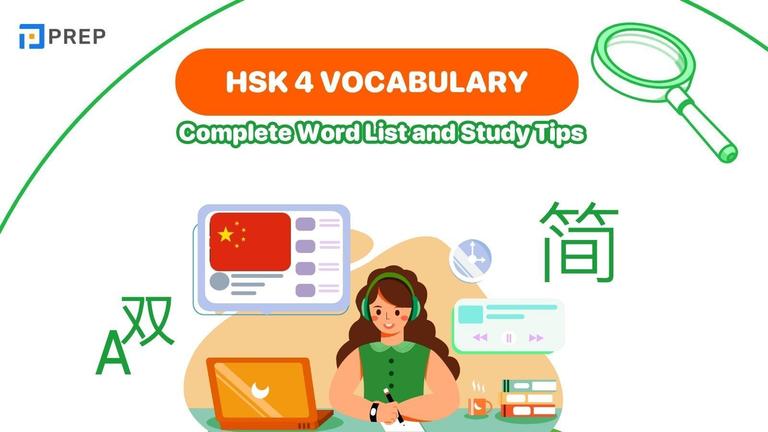A complete summary of the most accurate English pronunciation rules
In addition to mastering grammatical and vocabulary knowledge, you need to learn English pronunciation rules to improve your communication skills. In the article below, PREP summarizes the most accurate English pronunciation rules that you should save right away!
- I. Standard IPA English pronunciation rules
- II. English Pronunciation Rules - Stress Rules
- III. English pronunciation rules for some suffixes
- IV. English pronunciation rules - Linking rules
- V. English pronunciation rules - Chunking rules
- VI. English pronunciation rules - Intonation rules
- VII. 7 Proven Strategies to Master English Pronunciation
- VIII. Crack the IELTS Exam With Confidence

I. Standard IPA English pronunciation rules
Firstly, PREP will provide information about the standard IPA pronunciation rules:
1. What is IPA?
IPA stands for International Phonetic Alphabet. IPA is a phonetic symbol system created and used by linguists to accurately and distinctly represent the sounds of language. IPA is studied and developed by the International Phonetics Association.
The principles of IPA provide a unique symbol for each sound unit, used to distinguish single sounds that are written by combining two different letters, and words that are written the same but pronounced differently. The letters in the chart will each have only one singular way of pronunciation, regardless of their position within a word.
2. Structure of IPA
The IPA chart consists of 44 sounds, including both vowel sounds and consonant sounds. Specifically:
- 20 vowel sounds: 12 monophthongs and 8 diphthongs.
- 24 consonant sounds: unvoiced consonants and voiced consonants.
Refer to some more articles:
- The guidance to pronounce O accurately like a native English speaker
- Master English pronunciation: six ways to pronounce A
3. The reading method of the IPA chart - English pronunciation rules
Let’s read each individual sound carefully, grasping the English pronunciation rules in a scientific and detailed manner. When learning, compare similar sounds and take note of sounds that are easily confused. After thoroughly reading the individual sounds, begin learning sounds in different positions such as at the beginning, end, or middle of words.

4. Basic English pronunciation exercises
Choose the word whose underlined syllable is pronounced differently from the other words:
|
Exercise 1 |
1. A. rough B. sum C. utter D. union |
|
Exercise 2 |
1. A. hear B. clear C. bear D. ear |
Key:
- EX 1: 1d 2c 3a 4b 5a 6a 7a 8d 9d 10b
- EX 2: 1c 2b 3a 4d 5a 6c 7d 8d 9b 10b
II. English Pronunciation Rules - Stress Rules

Understanding and grasping stress rules clearly will help you pronounce with better intonation, sounding more natural and like a native speaker. Below are 15 stress marking rules you should know:
1. English pronunciation rules with two-syllable words
- Rule 1:
- For two-syllable verbs, the main stress is placed on the second syllable. For example: assist /əˈsɪst/; destroy /dɪˈstrɔɪ/.
- However, some two-syllable verbs place the main stress on the first syllable. For example: open /ˈəʊ.pən/; listen /ˈlɪs.ən/
- Rule 2: Most two-syllable nouns and adjectives place the main stress on the first syllable. For example: mountain /ˈmaʊn.tən/; handsome /ˈhæn.səm/
- Rule 3:
- The stress of some words can change depending on their part of speech. For words that can be both nouns and verbs, if it's a noun then the stress falls on the first syllable, if it's a verb then the stress falls on the second syllable. For example: Record (v) /rɪˈkɔːrd/ and record (n) /ˈrek.ɚd/.
- Exception: visit /ˈvɪz.ɪt/, travel /ˈtræv.əl/, promise /ˈprɑː.mɪs/: the stress always falls on the first syllable.
2. English pronunciation rules with three or more syllables words
- Rule 1: For words ending with -ic, -ian, -tion, -sion, the stress typically falls on the syllable before. For example: precision /prɪˈsɪʒ.ən/; scientific /ˌsaɪənˈtɪf.ɪk/.
- Rule 2: For words ending with -ade, -ee, -ese, -eer, -eete, -oo, -oon, -ique, -aire, the stress falls on that ending. For example: Vietnamese /ˌvjet.nəˈmiːz/, questionnaire /ˌkwes.tʃəˈneər/.
- Rule 3: For words ending in al, ful, y, the stress falls on the third syllable from the end. For example: natural /ˈnætʃ.ər.əl/, ability /əˈbɪl.ə.ti/.
- Rule 4: Prefixes are unstressed, and the following syllable is usually stressed. For example: unable /ʌnˈeɪ.bəl/, illegal /ɪˈliː.ɡəl/.
- Rule 5: For words ending with -ever, the stress falls on that ending. For example: whatever /wɒtˈev.ər/, whenever /wenˈev.ər/.
3. Stress marking rules with compound words
- Rule 1: The stress in compound nouns falls on the first syllable. For example: raincoat /ˈreɪŋ.kəʊt/, sunrise /ˈsʌn.raɪz/.
- Rule 2: The stress in compound adjectives falls on the second syllable. For example: bad-tempered /ˌbædˈtemp.əd/, short-term /ˌʃɔːtˈtɜːm/.
- Rule 3: The stress in compound verbs falls on the second syllable. For example: undertake /ˌʌn.dəˈteɪk/, overcome /ˌəʊ.vəˈkʌm/.
4. Stress exercises
Choose the word that has a stress pattern different from that of the other words.
- Question 1: A. occurrence B. preference C. particular D. spectator
- Question 2: A. pioneer B. principle C. architect D. military
- Question 3: A. utterance B. performance C. attendance D. reluctance
- Question 4: A. terrorist B. terrific C. librarian D. respectable
- Question 5: A. achievement B. ferocious C. adventure D. orient
- Question 6: A. abduction B. ablaze C. abnormal D. absolutely
- Question 7: A. abbreviate B. abandon C. abdication D. abscond
- Question 8: A. abnormality B. abstention C. abortive D. inferior
- Question 9: A. brotherhood B. cluster C. alimony D. enquiry
- Question 10: A. enterprise B. differentiate C. diabetes D. diagnosis
Key:
|
1. B |
2. A |
3. A |
4. A |
5. D |
|
6. D |
7. C |
8. A |
9. D |
10. A |
III. English pronunciation rules for some suffixes
Some special suffixes in English, such as s/es; or -ed, have their own pronunciation rules.
1. English pronunciation rules for the suffix s/es
The suffix s/es has 3 main pronunciation patterns:
|
Pronunciation |
Pronunciation rules for s/es |
Example |
|
/s/ |
Ending with voiceless consonants: /θ/, /f/, /k/, /p/, /t/ |
|
|
/z/ |
Ending with voiced consonants or ending with a vowel. |
|
|
/iz/ |
Ends with voiceless consonants: /s/ /ʃ/ /ʧ/ and voiced consonants /z/ /ʒ/, /dʒ/ |
|
2. English pronunciation rules for the suffix ed
The suffix ed follows these pronunciation rules:
|
Pronunciation |
Pronunciation rules for ed |
Example |
|
/t/ |
Verbs ending with unvoiced consonant /s/, /f/, /p/, /ʃ/, /tʃ/, /k/ |
|
|
/id/ |
Verbs ending with /t/ hay /d/ |
|
|
/d/ |
Verbs ending with a vowel or voiced consonant /l/, /n/, /r/, /b/, /g/, /m/, /z/, /s/, /v/ |
|
3. English pronunciation exercise with the suffix s/es, ed
3.1. English pronunciation exercise with the suffix s/es
Choose the word with a different pronunciation of s/es from the others:
- 1. A. proofs B. books C. points D. days
- 2. A. helps B. laughs C. cooks D. finds
- 3. A. neighbors B. friends C. relatives D. photographs
- 4. A. snacks B. follows C. titles D. writers
- 5. A. streets B. phones C. books D. makes
- 6. A. cities B. satellites C. series D. workers
- 7. A. develops B. takes C. laughs D. volumes
- 8. A. phones B. streets C. books D. makes
- 9. A. proofs B. regions C. lifts D. rocks
- 10. A. involves B. believes C. suggests D. steals
Key: 1 – D, 2- D, 3 – D, 4- A, 5- B, 6 – B, 7 – D, 8 – A, 9 – B, 10 – C
3.2. English pronunciation exercise with the suffix ed
Choose the word with a different pronunciation of ed from the others:
|
1. A. arrived |
B. believed |
C. received |
D. hoped |
|
2. A. opened |
B. knocked |
C. played |
D. occurred |
|
3. A. rubbed |
B. tugged |
C. stopped |
D. filled |
|
4. A. dimmed |
B. traveled |
C. passed |
D. stirred |
|
5. A. tipped |
B. begged |
C. quarreled |
D. carried |
|
6. A. tried |
B. obeyed |
C. cleaned |
D. asked |
|
7. A. packed |
B. added |
C. worked |
D. pronounced |
|
8. A. watched |
B. phoned |
C. referred |
D. followed |
|
9. A. agreed |
B. succeeded |
C. smiled |
D. loved |
|
10. A. laughed |
B. washed |
C. helped |
D. weighed |
Key: 1 – D, 2 – B, 3 – C, 4 – C, 5 – A, 6 – D, 7 – B, 8 – A, 9 – B, 10 – D
IV. English pronunciation rules - Linking rules

After learning to accurately read each syllable that makes up a word and determine stress patterns, the next important concept is linking rules. So, how many linking rules are there in English that you need to remember? Here are some important rules that you should memorize:
1. English pronunciation rules: consonant to vowel linking
When a word ends in a consonant sound and the following word begins with a vowel sound, the consonant is carried over and connected to the beginning vowel of the next word. In other words, the second word will sound like it starts with the final consonant of the previous word.
For example:
- She can‿always help‿us.
- This‿is‿an exciting event.
2. English pronunciation rules: vowel to vowel linking
When one word ends in a vowel and the following word begins with a vowel, the ending vowel of the first word flows into the beginning vowel of the next word. Some specific linking conventions include:
- If the first word ends in a short vowel /ɪ/ or /iː/, or diphthongs /aɪ/, /eɪ/ or /ɔɪ/ and the next word starts with any vowel, a /j/ sound is inserted between the words. For example: Say it: /sei jit/.
- If the first word ends in a rounded vowel, a /w/ sound is used to connect to the next word. For example: Do it: /du: wit/.
- If the first word ends in a long vowel where the lips are spread (words like 'e', 'i'), a /j/ sound joins the words. For example: I ask: /ai ya:sk/.
3. English pronunciation rules: consonant to consonant linking
In the English pronunciation rules, when there are 2 or more consonants in the same group standing close together, we only pronounce one consonant. For example: With thanks : /wɪ ‘θ:æ̃ŋks/.
Some consonant linking rules:
- /t/ + /j/ ➡ /tʃ/. Ví dụ: But use your head: /bətʃuːz jɔː hed/.
- /d/ + /j/ ➡ / dʒ/. Ví dụ: She had university students: /ʃiː hædʒuːniːˈvɜːsɪti ˈstjuːdənts/.
4. Liking exercise
Read aloud and apply the liking rules to the following words:
- Look at that! - /lʊ kæt ðæt/
- Would you help me? - /wʊ dʒu hɛlp mi/
- Press your hands together - /prɛ ʃər hændz təˈgɛðər/
Regularly practicing the Shadowing technique - imitate the exact English speech you hear with native speakers' dialogues to improve natural liking skills!
V. English pronunciation rules - Chunking rules

To sound warmer, authentic, and natural when speaking English, it is helpful to understand "chunking" strategies. Here are some basic chunking rules:
1. Rule 1: Remember the available chunking
The first rule is to adhere to the available chunks: collocation (words that commonly go together to form familiar phrases with set meanings), Fixed expressions (Fixed Expressions are unchanged phrases in English, but not idioms), Phrasal verbs (verb phrases are combined with verbs with adverbs, PREPositions), Discourse markers. For these types, it is best to say them together smoothly rather than breaking them up.
For example:
- Collocation: pose/ trigger a problem - /pəʊz / ˈtrɪɡ.ər eɪ prɒb.ləm/, do wonders for.
- Fixed expressions: day by day, now and then, ups and down.
- Phrasal verbs: take off, set off.
- Discourse markers: by the way, like I said.
2. Rule 2: Chunking based on punctuation
Chunking can also be based on punctuation. This is the most basic sign when practicing speaking: pause according to the rhythm of periods, commas, etc. to make the paragraph, and speech more natural. This is also the easiest rule to remember and implement in the chunking part (for sample answers when practicing).
3. Rule 3: Chunking after a sentence or meaningful phrase
In English-speaking tests or daily communication, chunking rules depend on the speech. We need to pause after a sentence or meaningful phrase. Avoid free pauses.
4. Practice chunking rules with the following paragraph
“Okay so, / I’m going to tell you about an activity that I like to do / with an elderly person in my family, / and that is playing backgammon / with my mother.
You know backgammon is quite a popular board game back at home, / and whenever I go home and visit my mother, / you know we always sit down with a cup of tea / in the evening / and we have a few games of backgammon.”
(The / marks the chunk).
VI. English pronunciation rules - Intonation rules
Intonation refers to the rise or fall of the voice when speaking. With proper intonation patterns, speech flows more smoothly and engagingly. It also supports authentically conveying emotions. Some important intonation principles to keep in mind include:
1. Intonation with stress
The stress in a sentence usually falls on content words - the words that carry the meaning of the sentence, such as nouns, verbs, etc.
For example: I think there are a number of reasons for this.
This sentence has important content words like think (verb) và number, reasons (noun).
2. Intonation and content
Intonation rises and falls depending on the content of the sentence. Here are some rules for rising and falling intonation:
|
Intonation rules |
Cases |
|
Rising intonation |
|
|
Falling intonation |
|
3. Practice intonation rules
Mark the intonation and practice with the following sentences:
Fill in ↓ (falling intonation) or ↑ (rising intonation) in the following sentences:
- What are you learning?
- Do you want to learn English?
- Of course, but I don’t know where.
- I will learn pronunciation there immediately.
Key:
- What are you doing? ↓
- Do you want to learn English? ↑
- Of course, but I don’t know where? ↑
- I will learn pronunciation there immediately. ↓
VII. 7 Proven Strategies to Master English Pronunciation
Transforming your English pronunciation requires both knowledge and practice. Apply these evidence-based strategies to achieve significant improvements in your spoken English:
1. Select a Specific Accent Model
Rather than mixing pronunciation patterns, commit to either British or American English as your foundation. Each has distinct sound systems, rhythms, and intonation patterns. This focused approach prevents confusion and accelerates progress by providing consistent pronunciation models to follow.
2. Employ Audio-Visual Learning
Utilize technology that shows mouth positions and tongue placement for challenging sounds. Watch slow-motion videos of native speakers articulating difficult phonemes, then practice in front of a mirror to compare your mouth movements with theirs. This physical awareness builds muscle memory essential for authentic pronunciation.
3. Master the International Phonetic Alphabet (IPA)
Learning IPA symbols gives you a powerful tool to decode any pronunciation regardless of spelling inconsistencies. When you encounter a new word, check its phonetic transcription in a quality dictionary to pronounce it correctly from the first attempt, eliminating the formation of bad habits.
4. Practice Shadowing Technique Daily
Shadow native speakers by repeating exactly what they say, with the same rhythm and intonation, just 1-2 seconds after hearing it. This research-backed technique trains your ear and speech organs simultaneously, developing natural speech patterns that mere repetition cannot achieve.
5. Record and Analyze Your Speech
Make short recordings of yourself reading passages, then critically compare them with native speaker versions. Modern pronunciation apps can highlight specific sounds needing improvement and track your progress over time, providing objective feedback on your development.
6. Focus on Prosodic Features
Move beyond individual sounds to master stress, rhythm, and intonation patterns that give English its distinctive flow. Marking stressed syllables in written texts before reading aloud helps internalize these patterns, which often contribute more to comprehensibility than perfect phoneme production.
7. Engage in Regular Conversation Practice
Apply your skills in authentic contexts through language exchange partners, conversation clubs, or speech recognition technology. This real-world application cements pronunciation improvements and builds confidence in communication settings where it matters most.
Consistent application of these strategies, even for just 15-20 minutes daily, will yield substantial improvements in your English pronunciation within weeks, transforming how others perceive and understand your speech.
VIII. Crack the IELTS Exam With Confidence
Struggling with Speaking? Our specialized modules focus on the toughest parts of the IELTS exam, ensuring you excel where it matters most:
- IELTS online course: Score Big in IELTS With Our Expert Tips!

Hi I'm Chloe, and I am currently serving as an Product Content Administrator at Prep Education. With over five years of experience in independent online IELTS study and exam preparation, I am confident in my ability to support learners in achieving their highest possible scores.
Comment
Premium content
View allPersonalized roadmap
Most read












